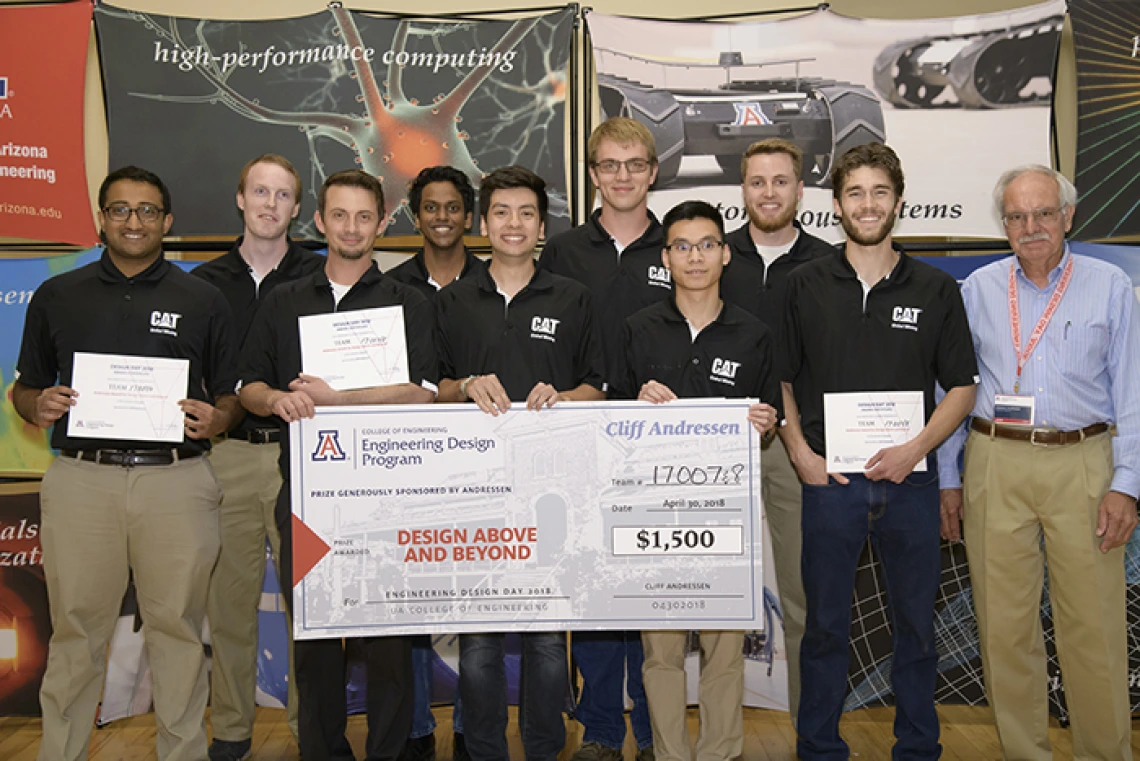Mining Machine Team Digs Deep at Design Day, Wins New Award


Project Title: Advanced Mining Machine Concept
Team 17007 and 17008 Members:
Matthew Hilton, mechanical engineering
Nathaniel Matesich, mechanical engineering
Owen David Pierce, mechanical engineering
Gaurav Sathish, mechanical engineering
Don C. Uvindra Sirimanne, mechanical engineering
Brian C. Cebrynski, engineering management
Maximilian Garber, mechanical engineering
Dylan Arthur Guenther, mechanical engineering
Ivan Llancas, systems engineering
Duy Trong Van, mechanical engineering
Sponsor: Caterpillar
New Award Recognizes Projects with Outstanding Design Solutions
Cliff Andressen earned a degree in physics from Loyola University and spent 45 years working as an engineer, 13 of those years at Raytheon. When he retired, he moved to Tucson, and he and his wife joined the UA College of Engineering’s da Vinci Circle.
When the pair saw some of the projects from the college’s annual Engineering Design Day on display at a da Vinci dinner, they decided to check out the next Design Day for themselves.
“I found it fascinating how good some of the projects are,” Andressen said. “I was just awed by the quality of work that UA students were doing.”
When he saw how excited the students were to win awards at Design Day, he decided it was a cause worth contributing to. He sponsored the Andressen Award for Design Above and Beyond, which recognizes projects that exceed requirements and produce results that could influence the development of other products, for the first time at the 2018 event.
“I really like the UA College of Engineering,” he said. “They’re teaching the kids to think, not just to turn the crank.”
Surface Mining System Designed to Impress
When he surveyed this year’s Engineering Design Day, he was immediately impressed by a rare project that involved two groups of seniors — teams 17007 and 17008. Their task: to design and build a small-scale prototype for a surface mining machine that could replace both the electric rope shovel and the hydraulic rope shovel.
“They came up with a totally new way of mining in terms of doing the digging,” Andressen said. “It wasn’t just a shovel with a bulldozer. It was a whole system that allows you to simultaneously extricate and haul off material.”
Finding Success by Joining Forces
Developing the design had its challenges. Project sponsor Caterpillar assigned 10 seniors to work on the project, giving them the option to either split into two teams or work together.
Initially working as two teams, the students realized halfway through the year that the scope of the project called for a combined effort. They took the two design concepts they had developed, performed trade studies to compare pros and cons, and let their sponsor choose between the designs when the results were too close to call.
“This project was largely a systems engineering project, so I, like the rest of the team, was taken out of my comfort zone a bit,” said team member Dylan Guenther, a mechanical engineer. “This has given me a more versatile set of experiences and skills than I would have had on a more formal project. I am certain that this experience will help me get a job and perform it well.”
Andressen, too, was impressed by the real-world experience all teams were receiving — and the valuable input and brainpower the sponsoring companies were gaining. Students were being challenged not just for the sake of a challenge, but because they were working on problems relevant to today’s world, he said.
Despite the all-nighters and unexpected twists and turns along the way, Guenther said he wouldn’t trade the experience. His favorite part was the camaraderie among his teammates that carried them through every trial.
“This was also the most surprising aspect of the project to me: the fact that you can strain so hard and exhaust yourself so much but really love every minute of it, just because of the people around you,” he said.

